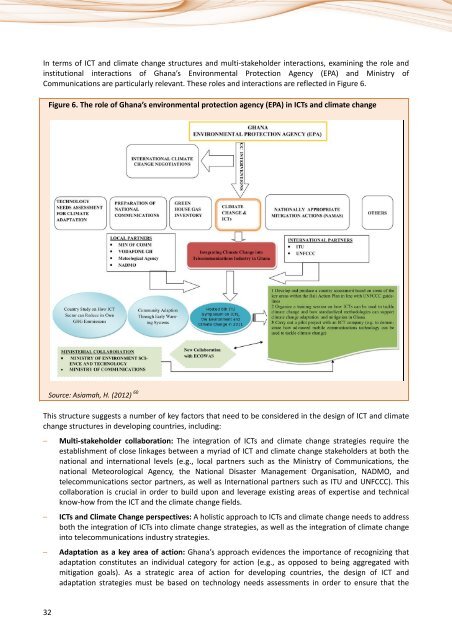Information and communication technologies (ICTs) and ... - ITU
Information and communication technologies (ICTs) and ... - ITU
Information and communication technologies (ICTs) and ... - ITU
You also want an ePaper? Increase the reach of your titles
YUMPU automatically turns print PDFs into web optimized ePapers that Google loves.
In terms of ICT <strong>and</strong> climate change structures <strong>and</strong> multi-stakeholder interactions, examining the role <strong>and</strong><br />
institutional interactions of Ghana’s Environmental Protection Agency (EPA) <strong>and</strong> Ministry of<br />
Communications are particularly relevant. These roles <strong>and</strong> interactions are reflected in Figure 6.<br />
Figure 6. The role of Ghana’s environmental protection agency (EPA) in <strong>ICTs</strong> <strong>and</strong> climate change<br />
Source: Asiamah, H. (2012) 60<br />
This structure suggests a number of key factors that need to be considered in the design of ICT <strong>and</strong> climate<br />
change structures in developing countries, including:<br />
– Multi-stakeholder collaboration: The integration of <strong>ICTs</strong> <strong>and</strong> climate change strategies require the<br />
establishment of close linkages between a myriad of ICT <strong>and</strong> climate change stakeholders at both the<br />
national <strong>and</strong> international levels (e.g., local partners such as the Ministry of Communications, the<br />
national Meteorological Agency, the National Disaster Management Organisation, NADMO, <strong>and</strong><br />
tele<strong>communication</strong>s sector partners, as well as International partners such as <strong>ITU</strong> <strong>and</strong> UNFCCC). This<br />
collaboration is crucial in order to build upon <strong>and</strong> leverage existing areas of expertise <strong>and</strong> technical<br />
know-how from the ICT <strong>and</strong> the climate change fields.<br />
– <strong>ICTs</strong> <strong>and</strong> Climate Change perspectives: A holistic approach to <strong>ICTs</strong> <strong>and</strong> climate change needs to address<br />
both the integration of <strong>ICTs</strong> into climate change strategies, as well as the integration of climate change<br />
into tele<strong>communication</strong>s industry strategies.<br />
– Adaptation as a key area of action: Ghana’s approach evidences the importance of recognizing that<br />
adaptation constitutes an individual category for action (e.g., as opposed to being aggregated with<br />
mitigation goals). As a strategic area of action for developing countries, the design of ICT <strong>and</strong><br />
adaptation strategies must be based on technology needs assessments in order to ensure that the<br />
32

















